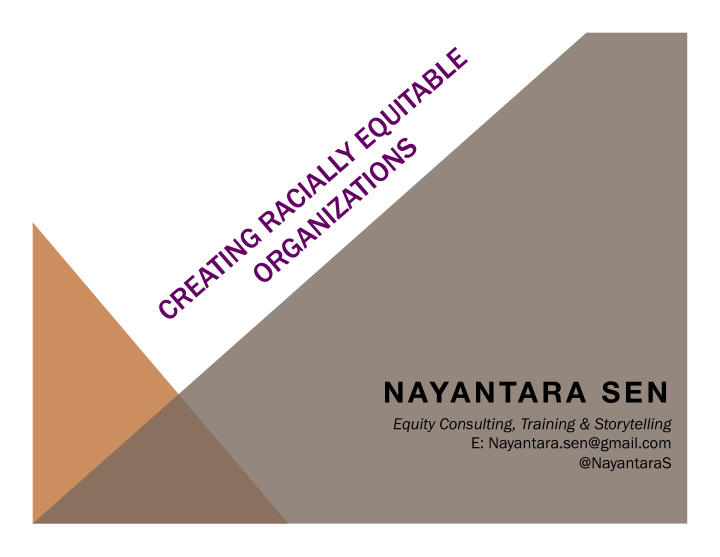



NAYANTARA SEN Equity Consulting, Training & Storytelling E: Nayantara.sen@gmail.com @NayantaraS
NPIC ORGANIZATIONAL CULTURE = � WHITE PROFESSIONALISM
WHITE PRIVILEGE &SUPREMACY IN NON-PROFITS � (A FEW SOBERING EXAMPLES ) Organizational Policies Organizational Practices “Accrual” policies for paid leave or vacation time that prevent immigrant Racial Microaggressions… workers from going home… Missing/inadequate equity strategies (like Expectations of “professional” behavior, affirmative action, staff and supervisor including dress code, language, voice, evaluations based on racial equity metrics, writing style, etc. No space allowed for “racial climate” assessments)… creative “code-switching”… “Diversity hiring requirements” without adequate supports for staff of color, Emphasis on tracking and evaluating resulting in diversity pitfalls like performance (as “work ethic”) without tokenization, exceptionalizing etc… attention to racial dynamics…. Deprioritizing mentorship, leadership Expecting staff of color to shoulder development and retention of staff of color “educational burden” on race/racism… while lifting up “professional and skills development”… ….etc.
CONCEALING RACISM: COMMON INSTITUTIONAL TECHNIQUES 1. Denying : Ignore racism or actively asserting it doesn’t exist. 2. Deflecting : Insist that inequity is based on anything but race, such as class, culture, family values, or work ethic 3. Coding : Use placeholder words, symbols or images to allude to racial fears. “Eg. Inner city, urban, terrorist,” etc. 4. Scapegoating : Blame those adversely affected by racism for their own plight in order to allocate responsibility on individuals instead of biased institutions. 5. Exceptionalizing : Acknowledge “bad apples” but refuse wider institutional patterns of discrimination. 6. Confusing : Use people of color as spokespersons or authority figures to refute claims of racism. 7. Mythologizing : Downplay racism by appealing to popular cultural myths, such as: meritocracy or “bootstraps”; level playing field, and colorblindness. INTERRUPT THESE DYNAMICS BY: NAMING, FRAMING, EXPLAINING AND PROVING RACISM Source: Terry Keleher, RaceForward
In organizations, implicit/unconscious racial biases becomes cumulative, compounded, institutionalized and operationalized over time. Implicit Racial Bias is the default setting for organizations. We must learn to anticipate, predict and prevent it. Just as racism operates institutionally and systemically, so too must racial equity in order to perpetually supplant racism. Source: RaceForward.org
INSTITUTIONAL SOLUTIONS: Create organizational culture and practice of equity through : • Diffusing responsibility for racial equity (vs siloing) • Operationalizing • Systematizing • Embedding/”Baking In” into organizational culture • Creating new habitual norms and behaviors
SOME TOOLS FOR ORGANIZATIONAL CHANGE: • Equity P Primes es, T , Trigger ers a and P Protocols Short-Term Long-Term Primes/Prompts à à Protocols • Organi nizationa nal C l Cho hoice P Point nts • Equity F y Filt lters a and nd B Budgeting ng • Racial E Equity Im Impact As Asses essmen ents ( (REIA) IA) • Staff T Traini ning ngs a and nd C Coachi hing ng • Di Disaggregated Da Data a and nd M Metrics b by R y Race a and nd E Ethni hnicity y • Workp kpla lace C Campaigni ning ng • Equity-F -Focused P Program P m Pla lanni nning ng a and nd E Evalu luation Gu n Guides • Organizational Wh Wheel eel o of C Change e • Workplace A e Advocacy a and O Organizing F Frameworks a and S Strateg egies es* ( (March 7 7, , 20 2016) 6) Note : Crea No eate b e both s standardized ed a and c custom eq equity a approaches es f for y your organization. .
!
Recommend
More recommend